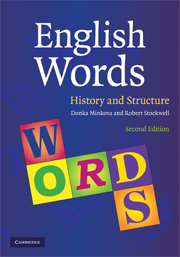Book contents
- Frontmatter
- Contents
- Preface to the second edition and acknowledgements
- An introduction to the textbook
- 1 Word-origins
- 2 The background of English
- 3 Composition of the Early Modern and Modern English Vocabulary
- 4 Smaller than words: morphemes and types of morphemes
- 5 Allomorphy, phonetics, and affixation
- 6 Replacement rules
- 7 Deletion rules and other kinds of allomorphy
- 8 Fossilized allomorphy: false cognates and other etymological pitfalls
- 9 Semantic relations and semantic change
- 10 The pronunciation of classical words in English
- Appendix: morpheme list
- Index
- References
Appendix: morpheme list
Published online by Cambridge University Press: 05 June 2012
- Frontmatter
- Contents
- Preface to the second edition and acknowledgements
- An introduction to the textbook
- 1 Word-origins
- 2 The background of English
- 3 Composition of the Early Modern and Modern English Vocabulary
- 4 Smaller than words: morphemes and types of morphemes
- 5 Allomorphy, phonetics, and affixation
- 6 Replacement rules
- 7 Deletion rules and other kinds of allomorphy
- 8 Fossilized allomorphy: false cognates and other etymological pitfalls
- 9 Semantic relations and semantic change
- 10 The pronunciation of classical words in English
- Appendix: morpheme list
- Index
- References
Summary
This list includes all morphemes cited and glossed in the Root Exercises of the Workbook (Part B in each chapter), plus the affixes cited in Chapter 5 of the Textbook. The numbers in parentheses correspond to the chapter of the Workbook in which the morpheme is introduced for study or memorization.
This appendix does not include many other morphemes introduced as examples in the textbook.
Notation: In the list of examples, Latinate words, if any, are listed first. If words of ultimately Greek origin exist, they follow, separated by a semicolon. Unless otherwise noted, Greek words can be assumed to have been borrowed through the medium of Latin. In the rare cases where a word was borrowed or coined directly from Greek, the word is italicized. If only Latinate or only Greek words are present in the examples, the source is marked as respectively “L” or “G.” If both are present, the Proto-Indo-European root, marked with an asterisk, is given where transparent. Otherwise the Latin and Greek derivatives are listed separately. Hybrid words are not marked. The connecting vowel and thematic vowel -o-, if it appears in any of the examples provided, is given in parentheses for Proto-Indo-European and Greek forms. In Latin the connecting vowel underwent vowel weakening to -i- but the thematic vowel to -u-, and very often neither is found in any of the examples, so no vowel is listed for the sake of simplicity.
- Type
- Chapter
- Information
- English WordsHistory and Structure, pp. 200 - 215Publisher: Cambridge University PressPrint publication year: 2009



